 Two weekends ago, I ran a challenge to design the as-of-yet unspoiled members of M15's Soul of [Plane] cycle. As usual, there were a lot of good and interesting designs, and I gave feedback around what seemed more and less likely. Now that the rest of the Souls have been spoiled, it's more clear how accurate some of that feedback was, and where it could have been better. Let's talk about that.
Two weekends ago, I ran a challenge to design the as-of-yet unspoiled members of M15's Soul of [Plane] cycle. As usual, there were a lot of good and interesting designs, and I gave feedback around what seemed more and less likely. Now that the rest of the Souls have been spoiled, it's more clear how accurate some of that feedback was, and where it could have been better. Let's talk about that.[Spoilers ahead but no amateur designs]
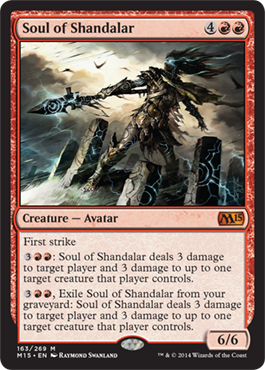 I claimed that first strike is a slightly awkward ability on a cycle of 6/6s because it allows that member to trump the rest in combat. That's not untrue, but the counter to that is that it will come up so infrequently in Limited that it would be silly to make any decisions based on it. If the Souls prove Constructed-worthy (and they will—Wizards was not shy about pushing their appeal), that'll come up more often there, but we can't say how much without knowing if the Souls will be as ubiquitous as the Titans were. Even if every deck runs a playset of Souls in its color, is letting one trump the others in combat really a bad thing?
I claimed that first strike is a slightly awkward ability on a cycle of 6/6s because it allows that member to trump the rest in combat. That's not untrue, but the counter to that is that it will come up so infrequently in Limited that it would be silly to make any decisions based on it. If the Souls prove Constructed-worthy (and they will—Wizards was not shy about pushing their appeal), that'll come up more often there, but we can't say how much without knowing if the Souls will be as ubiquitous as the Titans were. Even if every deck runs a playset of Souls in its color, is letting one trump the others in combat really a bad thing?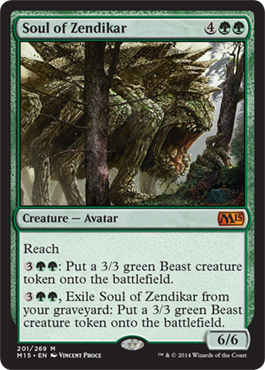 If the Soul with first strike had the weakest activated ability of the cycle, it would actually be a good thing, evening out their power levels.* But we know Soul of Shandalar isn't weaker than Soul of Zendikar (in the abstract) because it can kill the beasts the green Soul makes and deal damage to its controller for the same amount of mana.
If the Soul with first strike had the weakest activated ability of the cycle, it would actually be a good thing, evening out their power levels.* But we know Soul of Shandalar isn't weaker than Soul of Zendikar (in the abstract) because it can kill the beasts the green Soul makes and deal damage to its controller for the same amount of mana.
*That statement makes another assumption that might not hold up: That we want the value of each Soul to be as close as possible. There are two very real reasons we might not want that. First, it could easily be the case that the metagame is leaning in favor of one color over another, or that a particular archetype isn't quite feasible, and making one Soul better could even out that discrepancy or be the missing building block to make that archetype reasonable.
Secondly, Magic is not only a trading card game—a genre of game whose core identity rests on different cards having different value—but one that reinvents itself multiple times each year. For that reason, there's no motivation to make all cards of equal use, even within a tight cycle like this. The goal of such a cycle is to excite players and drive sales. As long as each card within it serves that purpose, it's not a problem if one is better or worse than the rest. In fact, it's a good thing. Let the players discuss, argue, agree and disagree: That interest keeps the community involved and the game strong.
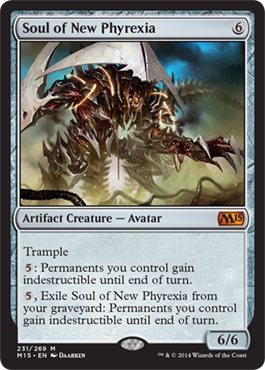 I also advised a designer that "All/Other creatures you control gain indestructible until EOT" was a suboptimal ability for a Soul because it made the principal differentiator of the cycle—that you can activate their abilities from the graveyard—less likely to be relevant. Again, not untrue, but almost immediately shown not to be reason enough to discard the idea. Soul of Phyrexia does it cheaper, without color requirements, and for all your permanents.
I also advised a designer that "All/Other creatures you control gain indestructible until EOT" was a suboptimal ability for a Soul because it made the principal differentiator of the cycle—that you can activate their abilities from the graveyard—less likely to be relevant. Again, not untrue, but almost immediately shown not to be reason enough to discard the idea. Soul of Phyrexia does it cheaper, without color requirements, and for all your permanents.
Why? Again, it all boils down to splash. The mythic rares exist to excite players and "Permanents you control gain indestructible" is exciting. Sure, you won't be using that from the graveyard as often as the other Souls, but is that such a bad thing? It's a little sloppy for a design, but players don't think about design. From a play-value perspective, this is a powerful ability on a well-costed fatty and the last ability being less irrelevant doesn't change that. Not to mention there are a fair number of cases where it will come up, not the least of which when your opponent manages to kill your Soul before you untap with it.
So was Soul of New Phyrexia a mistake? I can't speak with certainty having not seen the context in which it was developed, but even while I can say with confidence that this is a weaker design than the rest of the cycle, I have every faith that Wizards made the right call printing it. I mean, they make mistakes like anyone does, but their hit record is obscenely high and questioning that without full information would be the height of hubris.
My takeaway is that mythic rares don't just get exceptions in complexity and power level, but also in balance, synergy and design aesthetic, when doing so helps produce a card that can really drive interest in the set and sell boosters. For the rarity that only gets 15 slots in a large set, that makes good sense.
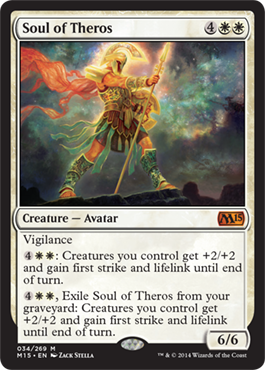 As long as we're here though, I want to look at the rest of the Souls and discuss an interesting property of designing large creatures. Let's look at all their keywords. Every ability gets better or worse as a creature's size grows. Flying scales linearly with the creature it's on; A 4-power flyer is twice as good as a 2-power flyer. Trample, on the other hand, gets better faster as the creature grows; Trample is irrelevant on a 1-power creature, but significant with 3- or 4-power, and huge on a fatty with 6+ power. How do the rest stack up?
As long as we're here though, I want to look at the rest of the Souls and discuss an interesting property of designing large creatures. Let's look at all their keywords. Every ability gets better or worse as a creature's size grows. Flying scales linearly with the creature it's on; A 4-power flyer is twice as good as a 2-power flyer. Trample, on the other hand, gets better faster as the creature grows; Trample is irrelevant on a 1-power creature, but significant with 3- or 4-power, and huge on a fatty with 6+ power. How do the rest stack up?
First strike is a bit weaker as we increase the size of a creature: Mano-a-mano, it doesn't matter if your creature has first strike when it's big enough to survive the fight anyhow. Where first strike does work for big un's is dissuading multiple blockers from ganging up and trading with it; I might not be happy to give up both my 3/3s to take out your 6/6, but I'll do it if it means your 6/6 can't kill me or block my army all day. With first strike in the mix, I'd need four 3/3s to make the same trade. So this keyword is far from irrelevant on a large creature, but doesn't increase it's value as much as it does medium and small creatures.
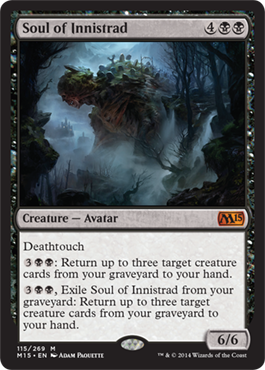 Deathtouch scales the worst. Once you breach the threshold of having positive power, your deathtouch creature will kill whatever it blocks. More power is still useful for bashing your opponent, but it only serves one purpose in creature-combat: You need 1 point of power for each blocker you want to kill. If three 1/1 spirits triple-block my Vampire Nighthawk, I can only take out two of them. Soul of Innistrad can take out six creatures in a multi-block situation. That sounds great, but triple-blocks are fairly rare and blocking with more creatures gets exponentially less likely. Besides, with six-power, you're probably going to kill about as many creatures as the opponent needs to block you with anyhow. Mostly deathtouch shines when trading up, and while you might feel okay trading your Soul for an opposing Kozilek, Butcher of Truth, it should never be your plan A.
Deathtouch scales the worst. Once you breach the threshold of having positive power, your deathtouch creature will kill whatever it blocks. More power is still useful for bashing your opponent, but it only serves one purpose in creature-combat: You need 1 point of power for each blocker you want to kill. If three 1/1 spirits triple-block my Vampire Nighthawk, I can only take out two of them. Soul of Innistrad can take out six creatures in a multi-block situation. That sounds great, but triple-blocks are fairly rare and blocking with more creatures gets exponentially less likely. Besides, with six-power, you're probably going to kill about as many creatures as the opponent needs to block you with anyhow. Mostly deathtouch shines when trading up, and while you might feel okay trading your Soul for an opposing Kozilek, Butcher of Truth, it should never be your plan A.
Reach grows closely in value with a creature's power, but not quite as fast as flying, because reach is purely defensive and the larger your creature is, the more you'd rather be attacking with it than blocking. Finally, vigilance grows the fastest as your creature gets bigger; The more damage it deals, and the less it has to fear from other creatures, they happier you are to use it twice per round.
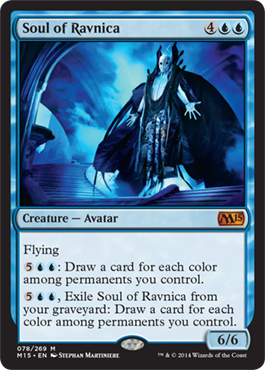 Every keyword scales better or worse on creatures of different sizes. As designers, we can use that to balance out a card's strength in an absolute sense (flying is better than reach at any size, but even moreso at 6+ power) as well as to balance cards relative to one another… Ignoring their activated abilities (and the decks they'd go in), Soul of Ravnica is a stronger card than Soul of Zendikar. Ignoring their keyword abilities, the green Soul has great value because you can always use creatures. The blue Soul could potentially draw you an absurd five cards, but it would take all of your mana for the turn to do it, and you've got to set up your board to get that much out of it, or indeed, more than a single card. Given how hard it can sometimes be to run a deck with four or five colors and to play out that many permanents without them getting killed, it wouldn't be hard to argue that cheaply making beasts is better than conditionally drawing cards. Considering the keyword and activated abilities together, it's safe to say that the cards are different, but comparable; one will be better than the other depending on each game's circumstances, but both are clearly very good.
Every keyword scales better or worse on creatures of different sizes. As designers, we can use that to balance out a card's strength in an absolute sense (flying is better than reach at any size, but even moreso at 6+ power) as well as to balance cards relative to one another… Ignoring their activated abilities (and the decks they'd go in), Soul of Ravnica is a stronger card than Soul of Zendikar. Ignoring their keyword abilities, the green Soul has great value because you can always use creatures. The blue Soul could potentially draw you an absurd five cards, but it would take all of your mana for the turn to do it, and you've got to set up your board to get that much out of it, or indeed, more than a single card. Given how hard it can sometimes be to run a deck with four or five colors and to play out that many permanents without them getting killed, it wouldn't be hard to argue that cheaply making beasts is better than conditionally drawing cards. Considering the keyword and activated abilities together, it's safe to say that the cards are different, but comparable; one will be better than the other depending on each game's circumstances, but both are clearly very good.
Returning from that broader perspective about big creatures in general, I'll share just a few more thoughts on the designs of the Souls in particular. The central idea of an avatar that represents an entire plane is rather strange, and super awesome. Each member of the cycle (with the exception of Shandalar, and maybe Zendikar) does a great job of evoking its plane's nature, which is fun from a Vorthos perspective, but the fact that they all do such different things also makes the whole cycle more interesting because they will inspire very different decks. Soul of Theros very much wants me to build up an army and Overrun my opponent, while Soul of Innistrad wants me to fill my graveyard with cheap creatures or for discard outlets, and so on. That variety seems wider than it had been for the Titans, the cycle that everyone will and should compare these to, and that—combined with hopefully not being quite as powerful (but still very)—gives me hope that these 6 cards will affect Constructed in a more healthy well, proving neither as ubiquitous, nor as homogenizing.
I'll leave you with the recommendation that if you haven't seen what the Goblin Artisans design community came up with for the challenge I mentioned, you really should check it out. They did great work, and there are an eerie number of similarities with the cards that have since been spoiled.
So was Soul of New Phyrexia a mistake? I can't speak with certainty having not seen the context in which it was developed, but even while I can say with confidence that this is a weaker design than the rest of the cycle, I have every faith that Wizards made the right call printing it. I mean, they make mistakes like anyone does, but their hit record is obscenely high and questioning that without full information would be the height of hubris.
My takeaway is that mythic rares don't just get exceptions in complexity and power level, but also in balance, synergy and design aesthetic, when doing so helps produce a card that can really drive interest in the set and sell boosters. For the rarity that only gets 15 slots in a large set, that makes good sense.
 As long as we're here though, I want to look at the rest of the Souls and discuss an interesting property of designing large creatures. Let's look at all their keywords. Every ability gets better or worse as a creature's size grows. Flying scales linearly with the creature it's on; A 4-power flyer is twice as good as a 2-power flyer. Trample, on the other hand, gets better faster as the creature grows; Trample is irrelevant on a 1-power creature, but significant with 3- or 4-power, and huge on a fatty with 6+ power. How do the rest stack up?
As long as we're here though, I want to look at the rest of the Souls and discuss an interesting property of designing large creatures. Let's look at all their keywords. Every ability gets better or worse as a creature's size grows. Flying scales linearly with the creature it's on; A 4-power flyer is twice as good as a 2-power flyer. Trample, on the other hand, gets better faster as the creature grows; Trample is irrelevant on a 1-power creature, but significant with 3- or 4-power, and huge on a fatty with 6+ power. How do the rest stack up?First strike is a bit weaker as we increase the size of a creature: Mano-a-mano, it doesn't matter if your creature has first strike when it's big enough to survive the fight anyhow. Where first strike does work for big un's is dissuading multiple blockers from ganging up and trading with it; I might not be happy to give up both my 3/3s to take out your 6/6, but I'll do it if it means your 6/6 can't kill me or block my army all day. With first strike in the mix, I'd need four 3/3s to make the same trade. So this keyword is far from irrelevant on a large creature, but doesn't increase it's value as much as it does medium and small creatures.
 Deathtouch scales the worst. Once you breach the threshold of having positive power, your deathtouch creature will kill whatever it blocks. More power is still useful for bashing your opponent, but it only serves one purpose in creature-combat: You need 1 point of power for each blocker you want to kill. If three 1/1 spirits triple-block my Vampire Nighthawk, I can only take out two of them. Soul of Innistrad can take out six creatures in a multi-block situation. That sounds great, but triple-blocks are fairly rare and blocking with more creatures gets exponentially less likely. Besides, with six-power, you're probably going to kill about as many creatures as the opponent needs to block you with anyhow. Mostly deathtouch shines when trading up, and while you might feel okay trading your Soul for an opposing Kozilek, Butcher of Truth, it should never be your plan A.
Deathtouch scales the worst. Once you breach the threshold of having positive power, your deathtouch creature will kill whatever it blocks. More power is still useful for bashing your opponent, but it only serves one purpose in creature-combat: You need 1 point of power for each blocker you want to kill. If three 1/1 spirits triple-block my Vampire Nighthawk, I can only take out two of them. Soul of Innistrad can take out six creatures in a multi-block situation. That sounds great, but triple-blocks are fairly rare and blocking with more creatures gets exponentially less likely. Besides, with six-power, you're probably going to kill about as many creatures as the opponent needs to block you with anyhow. Mostly deathtouch shines when trading up, and while you might feel okay trading your Soul for an opposing Kozilek, Butcher of Truth, it should never be your plan A.Reach grows closely in value with a creature's power, but not quite as fast as flying, because reach is purely defensive and the larger your creature is, the more you'd rather be attacking with it than blocking. Finally, vigilance grows the fastest as your creature gets bigger; The more damage it deals, and the less it has to fear from other creatures, they happier you are to use it twice per round.
 Every keyword scales better or worse on creatures of different sizes. As designers, we can use that to balance out a card's strength in an absolute sense (flying is better than reach at any size, but even moreso at 6+ power) as well as to balance cards relative to one another… Ignoring their activated abilities (and the decks they'd go in), Soul of Ravnica is a stronger card than Soul of Zendikar. Ignoring their keyword abilities, the green Soul has great value because you can always use creatures. The blue Soul could potentially draw you an absurd five cards, but it would take all of your mana for the turn to do it, and you've got to set up your board to get that much out of it, or indeed, more than a single card. Given how hard it can sometimes be to run a deck with four or five colors and to play out that many permanents without them getting killed, it wouldn't be hard to argue that cheaply making beasts is better than conditionally drawing cards. Considering the keyword and activated abilities together, it's safe to say that the cards are different, but comparable; one will be better than the other depending on each game's circumstances, but both are clearly very good.
Every keyword scales better or worse on creatures of different sizes. As designers, we can use that to balance out a card's strength in an absolute sense (flying is better than reach at any size, but even moreso at 6+ power) as well as to balance cards relative to one another… Ignoring their activated abilities (and the decks they'd go in), Soul of Ravnica is a stronger card than Soul of Zendikar. Ignoring their keyword abilities, the green Soul has great value because you can always use creatures. The blue Soul could potentially draw you an absurd five cards, but it would take all of your mana for the turn to do it, and you've got to set up your board to get that much out of it, or indeed, more than a single card. Given how hard it can sometimes be to run a deck with four or five colors and to play out that many permanents without them getting killed, it wouldn't be hard to argue that cheaply making beasts is better than conditionally drawing cards. Considering the keyword and activated abilities together, it's safe to say that the cards are different, but comparable; one will be better than the other depending on each game's circumstances, but both are clearly very good.Returning from that broader perspective about big creatures in general, I'll share just a few more thoughts on the designs of the Souls in particular. The central idea of an avatar that represents an entire plane is rather strange, and super awesome. Each member of the cycle (with the exception of Shandalar, and maybe Zendikar) does a great job of evoking its plane's nature, which is fun from a Vorthos perspective, but the fact that they all do such different things also makes the whole cycle more interesting because they will inspire very different decks. Soul of Theros very much wants me to build up an army and Overrun my opponent, while Soul of Innistrad wants me to fill my graveyard with cheap creatures or for discard outlets, and so on. That variety seems wider than it had been for the Titans, the cycle that everyone will and should compare these to, and that—combined with hopefully not being quite as powerful (but still very)—gives me hope that these 6 cards will affect Constructed in a more healthy well, proving neither as ubiquitous, nor as homogenizing.
I'll leave you with the recommendation that if you haven't seen what the Goblin Artisans design community came up with for the challenge I mentioned, you really should check it out. They did great work, and there are an eerie number of similarities with the cards that have since been spoiled.

Great analysis, Jay!
ReplyDeleteAs an aside, I do wish they had found designs that evoked their "homes" as well as Soul of Ravnica's does, but I suppose that may have come at the cost of making them obtuse or less playable (as with Soul of Ravnica). I mean, Zendikar didn't even have 3/3 Beast tokens! C'mon guys!
One note on larger creatures with deathtouch: Have you ever had to block and kill a Grave Titan with 3/3s and 4/4s against an opponent with open mana. Deathtouch punishes a triple or quad-block quite harshly, but the threat of Terror makes the minimum double-block potentially just as bad. This came up a bit more often with Grave Titan because it's ability was very close to "must attack" and "must be blocked and killed ASAP".
ReplyDeleteHey Jay, thinking about community-submitted renders again: would there be interest in having a simplistic "input text and upload image" block of HTML we could submit and you could embed? Wouldn't look as good as MSE for sure, but the gist would be there.
ReplyDeleteI am still unsure that Soul Of New Phyrexia's grave based ability is suboptimal. It's such a hard effect to play around. It stops Wrath effects cold and forces an opponent to double up on removal in a turn. So intead of a 1:1 like Hero's Downfall, they have to play a 2:2. Hero's Downfall + Doom Blade in repsonse to the graveyard effect.
ReplyDeleteI guess you could mean that Soul of New Phyrexia will never end up in the graveyard if it's constantly activating it's battlefield effect. But don't forget about Dissolve, Thoughtseize, Reprisal in response, Wear in Response, or good old Naturalize in response. There are lots of ways it can end up in the yard. At least enough that I see it's graveyard effect as being fine.
PS - When can we talk about including the Pain Lands in M15? That one is super confusing to me.
It's more a development discussion than Design, but what do you find confusing about their inclusion?
DeleteIt's been banged into our heads over and over that new players don't want to play cards that make them sacrifice permanents, or discard cards, or pay life for effects. core sets since M10 have had more and more sacrifice for effect cards, and 10 cards that ask you to discard cards for effects. But paying life for an effect has only been used twice: Demon of Death's Gate and Trading Post. I think new players accept those two cards bedcause of the effects they generate. But I'm less sure they'll want to pay life just to have access to mana. Pain lands don't belong in a core set.
DeleteWhen Sam Stoddard announced the enemy pain lands in his Friday article, part of the reason they were chosen was to support aggro decks. Orginally the lands in those 5 slots were Innistrad's enemy check lands. But coming into play tapped made it hard to support aggro, prompting the switch to pain lands. Why didn't they create 5 enemy lands to complete the full cycle of the Scars of Mirrodin fast lands? Razorverge Thicket and the other four were extremely popular and promoted aggro decks. If that's the goal, I think that design would have been a much better way to go.
While it may not have been made completely explicit, there was an insinuation that the Apocalypse pain lands were selected in part because they are already broadly circulated, thus helping keep the cost of manabases at a somewhat more reasonable level. The exclusion of the Ice Age pain lands seems to have been something of a "stylistic" decision — one that has made some players confused and anticipating Adarkar Wastes in Khans of Tarkir.
Delete10 pain lands is a lot in a single set. But why include any duals at all in the Core Set?
DeleteSam also stated in the article that 5 allied dual lands were kept out of M14 so each two color deck choice would have equal mana bases in Standard and in Block. And he said this is something they want to do moving forward. So I don't get how it will be possible for all decks to have equal mana bases now that M15 has a 5 enemy dual lands.
M14 had to deal with post-RtR standard, where each guild wanted to vie for a spot in the metagame. With Ravnica level guild loyalty phasing out, the manabases can be a little less balanced. I assume that they'll be doing 10 dual cycle in Khans, with the 5 allied in Khans and the other 5 spread across the second and third set.
DeleteTaking a look at the bigger picture though, I have to disagree with you about pain lands not belonging in a core set. I think many new players see some type of dual in a rare slot - think sunpetal grove and the other check lands - and are disappointed. Given the general quality expectations around Rares, a new player will more likely look at a pain land and immediately realize how important dual lands can be. If life payments, which newer players are hesitant to do in the first place, can show up on a rare land, that land must do something really special.
It gets them to ask the right questions.